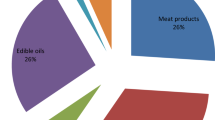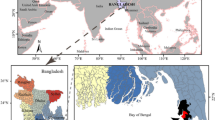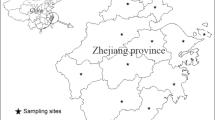Abstract
Endocrine disrupting chemicals (EDCs) consist of a diverse group of industrial chemicals and pharmacological agents. The use of instrumental analyses as the first screening tool might not be cost-effective to identify the existence of enormous numbers of chemical contaminants in environments. Also, knowledge of the concentration of individual residues is difficult to use to evaluate biological impacts of contaminants to wildlife and humans. The primary objective of the present study was to develop and to test the feasibility of using a battery of exposure biomarkers for the rapid-screening of various endocrine disrupting activities present in food. The measurement of the EDC-elicited activities involved various (i) receptor-mediated responses, including androgenic, estrogenic, dioxin-like, glucocorticoid-like, progesterone-like, peroxisome proliferator-like and retinoid-like as well as (ii) the non-receptor mediated responses through modulation of cellular reactive oxygen species (ROS) and ATP content. Samples of both local and imported pork, beef and chicken as well as freshwater and seawater fishes were collected. Extracts of different foods exhibited various dioxin-like and “hormonal” activities. Fish and chicken skin were found to be the major source of exogenous “hormonal” and dioxin-like substances in diets. Extracts of beef and pork contained lesser potencies of hormonally-active agents. Our data suggest that the proposed EDC-screening platform may be useful in a risk assessment for the routine monitoring of EDCs in foods. Continuous monitoring and research is warranted to assess the physiological consequences of the consumption.
This is a preview of subscription content, access via your institution
Access options
Subscribe to this journal
Receive 6 print issues and online access
$259.00 per year
only $43.17 per issue
Buy this article
- Purchase on Springer Link
- Instant access to full article PDF
Prices may be subject to local taxes which are calculated during checkout



Similar content being viewed by others
References
Anway M.D., Cupp A.S., Uzumcu M., and Skinner M.K. Epigenetic transgenerational actions of endocrine disruptors and male fertility. Science 2005: 308: 1466–1469.
Azad N., Iyer A., Vallyathan V., Wang L., Castranova V., Stehlik C., and Rojanasakul Y. Role of oxidative/nitrosative stress-mediated Bcl-2 regulation in apoptosis and malignant transformation. Ann N Y Acad Sci 2010: 1203: 1–6.
Barnes P.J. Mechanisms and resistance in glucocorticoid control of inflammation. J Steroid Biochem Mol Biol 2010: 120: 76–85.
Boisen K.A., Kaleva M., Main K.M., Virtanen H.E., Haavisto A.M., Schmidt I.M., Chellakooty M., Damgaard I.N., Mau C., Reunanen M., Skakkebaek N.E., and Toppari J. Difference in prevalence of congenital cryptorchidism in infants between two Nordic countries. Lancet 2004: 363: 1264–1269.
Bowles J., Knight D., Smith C., Wilhelm D., Richman J., Mamiya S., Yashiro K., Chawengsaksophak K., Wilson M.J., Rossant J., Hamada H., and Koopman P. Retinoid signaling determines germ cell fate in mice. Science 2006: 312: 596–600.
Bowles J., and Koopman P. Retinoic acid, meiosis and germ cell fate in mammals. Development 2007: 134: 3401–3411.
Bruner-Tran K.L., and Osteen K.G. Dioxin-like PCBs and endometriosis. Syst Biol Reprod Med 2010: 56: 132–146.
Cheung K.C., Leung H.M., Kong K.Y., and Wong M.H. Residual levels of DDTs and PAHs in freshwater and marine fish from Hong Kong markets and their health risk assessment. Chemosphere 2007: 66: 460–468.
Chrousos G.P., and Kino T. Glucocorticoid signaling in the cell. Expanding clinical implications to complex human behavioral and somatic disorders. Ann N Y Acad Sci 2009: 1179: 153–166.
Colborn T., vom Saal F.S., and Soto A.M. Developmental effects of endocrine-disrupting chemicals in wildlife and humans. Environ Health Perspect 1993: 101: 378–384.
Crain D.A., Janssen S.J., Edwards T.M., Heindel J., Ho S.M., Hunt P., Iguchi T., Juul A., McLachlan J.A., Schwartz J., Skakkebaek N., Soto A.M., Swan S., Walker C., Woodruff T.K., Woodruff T.J., Giudice L.C., and Guillette Jr L.J. Female reproductive disorders: the roles of endocrine-disrupting compounds and developmental timing. Fertil Steril 2008: 90: 911–940.
Den Hond E., and Schoeters G. Endocrine disrupters and human puberty. Int J Androl 2006: 29: 264–271.
Devasagayam T.P., Tilak J.C., Boloor K.K., Sane K.S., Ghaskadbi S.S., and Lele R.D. Free radicals and antioxidants in human health: current status and future prospects. J Assoc Physicians India 2004: 52: 794–804.
Diamanti-Kandarakis E., Bourguignon J.P., Giudice L.C., Hauser R., Prins G.S., Soto A.M., Zoeller R.T., and Gore A.C. Endocrine-disrupting chemicals: an Endocrine Society scientific statement. Endocr Rev 2009: 30: 293–342.
Diamanti-Kandarakis E., Palioura E., Kandarakis S.A., and Koutsilieris M. The impact of endocrine disruptors on endocrine targets. Horm Metab Res 2010: 42: 543–552.
Dolinoy D.C., Huang D., and Jirtle R.L. Maternal nutrient supplementation counteracts bisphenol A-induced DNA hypomethylation in early development. Proc Natl Acad Sci USA 2007: 104: 13056–13061.
Elahi M.M., Kong Y.X., and Matata B.M. Oxidative stress as a mediator of cardiovascular disease. Oxid Med Cell Longev 2009: 2: 259–269.
Feron V.J., Cassee F.R., Groten J.P., van Vliet P.W., and van Zorge J.A. International issues on human health effects of exposure to chemical mixtures. Environ Health Perspect 2002: 110 (Suppl 6): 893–899.
Folkerd E.J., and Dowsett M. Influence of sex hormones on cancer progression. J Clin Oncol 2010: 28: 4038–4044.
Franco R., Schoneveld O., Georgakilas A.G., and Panayiotidis M.I. Oxidative stress, DNA methylation and carcinogenesis. Cancer Lett 2008: 266: 6–11.
Goetz M.E., and Luch A. Reactive species: a cell damaging rout assisting to chemical carcinogens. Cancer Lett 2008: 266: 73–83.
Hotchkiss A.K., Rider C.V., Blystone C.R., Wilson V.S., Hartig P.C., Ankley G.T., Foster P.M., Gray C.L., and Gray L.E. Fifteen years after “Wingspread”—environmental endocrine disrupters and human and wildlife health: where we are today and where we need to go. Toxicol Sci 2008: 105: 235–259.
Judson R., Richard A., Dix D.J., Houck K., Martin M., Kavlock R., Dellarco V., Henry T., Holderman T., Sayre P., Tan S., Carpenter T., and Smith E. The toxicity data landscape for environmental chemicals. Environ Health Perspect 2009: 117: 685–695.
Kavlock R.J., Daston G.P., DeRosa C., Fenner-Crisp P., Gray L.E., Kaattari S., Lucier G., Luster M., Mac M.J., Maczka C., Miller R., Moore J., Rolland R., Scott G., Sheehan D.M., Sinks T., and Tilson H.A. Research needs for the risk assessment of health and environmental effects of endocrine disruptors: a report of the U.S. EPA-sponsored workshop. Environ Health Perspect 1996: 104 (Suppl 4): 715–740.
Leranth C., Hajszan T., Szigeti-Buck K., Bober J., and MacLusky N.J. Bisphenol A prevents the synaptogenic response to estradiol in hippocampus and prefrontal cortex of ovariectomized nonhuman primates. Proc Natl Acad Sci USA 2008: 105: 14187–14191.
Liem A.K., Furst P., and Rappe C. Exposure of populations to dioxins and related compounds. Food Addit Contam 2000: 17: 241–259.
Lin M.T., and Beal M.F. Mitochondrial dysfunction and oxidative stress in neurodegenerative diseases. Nature 2006: 443: 787–795.
Longui C.A., and Faria C.D. Evaluation of glucocorticoid sensitivity and its potential clinical applicability. Horm Res 2009: 71: 305–309.
Lukanova A., and Kaaks R. Endogenous hormones and ovarian cancer: epidemiology and current hypotheses. Cancer Epidemiol Biomarkers Prev 2005: 14: 98–107.
Makker K., Agarwal A., and Sharma R. Oxidative stress & male infertility. Indian J Med Res 2009: 129: 357–367.
Mantovani A., Maranghi F., Purificato I., and Macri A. Assessment of feed additives and contaminants: an essential component of food safety. Ann Ist Super Sanita 2006: 42: 427–432.
Migliore L., and Coppede F. Genetic and environmental factors in cancer and neurodegenerative diseases. Mutat Res 2002: 512: 135–153.
Paulozzi L.J. International trends in rates of hypospadias and cryptorchidism. Environ Health Perspect 1999: 107: 297–302.
Phillips K.P., and Foster W.G. Key developments in endocrine disrupter research and human health. J Toxicol Environ Health B Crit Rev 2008: 11: 322–344.
Phillips K.P., Foster W.G., Leiss W., Sahni V., Karyakina N., Turner M.C., Kacew S., and Krewski D. Assessing and managing risks arising from exposure to endocrine-active chemicals. J Toxicol Environ Health B Crit Rev 2008: 11: 351–372.
Poppenga R.H. Current environmental threats to animal health and productivity. Vet Clin North Am Food Anim Pract 2000: 16: 545–558, viii.
Pyper S.R., Viswakarma N., Yu S., and Reddy J.K. PPARalpha: energy combustion, hypolipidemia, inflammation and cancer. Nucl Recept Signal 2010: 8: e002.
Rao M.S., and Reddy J.K. Peroxisome proliferation and hepatocarcinogenesis. Carcinogenesis 1987: 8: 631–636.
Reddy J.K., Azarnoff D.L., and Hignite C.E. Hypolipidaemic hepatic peroxisome proliferators form a novel class of chemical carcinogens. Nature 1980: 283: 397–398.
Reddy J.K., Rao S., and Moody D.E. Hepatocellular carcinomas in acatalasemic mice treated with nafenopin, a hypolipidemic peroxisome proliferator. Cancer Res 1976: 36: 1211–1217.
Richman E.L., Stampfer M.J., Paciorek A., Broering J.M., Carroll P.R., and Chan J.M. Intakes of meat, fish, poultry, and eggs and risk of prostate cancer progression. Am J Clin Nutr 2010: 91: 712–721.
Roy J.R., Chakraborty S., and Chakraborty T.R. Estrogen-like endocrine disrupting chemicals affecting puberty in humans—a review. Med Sci Monit 2009: 15: RA137–RA145.
Sanderson J.T. The steroid hormone biosynthesis pathway as a target for endocrine-disrupting chemicals. Toxicol Sci 2006: 94: 3–21.
Shen H.M., and Liu Z.G. JNK signaling pathway is a key modulator in cell death mediated by reactive oxygen and nitrogen species. Free Radic Biol Med 2006: 40: 928–939.
Soto A.M., Rubin B.S., and Sonnenschein C. Interpreting endocrine disruption from an integrative biology perspective. Mol Cell Endocrinol 2009: 304: 3–7.
Soto A.M., and Sonnenschein C. Environmental causes of cancer: endocrine disruptors as carcinogens. Nat Rev Endocrinol 2010: 6 (7): 363–370.
Stadtman E.R., and Berlett B.S. Reactive oxygen-mediated protein oxidation in aging and disease. Drug Metab Rev 1998: 30: 225–243.
Stephany R.W. Hormonal growth promoting agents in food producing animals. Handb Exp Pharmacol 2010: 195: 355–367.
Stokes W.S. Selecting appropriate animal models and experimental designs for endocrine disruptor research and testing studies. ILAR J 2004: 45: 387–393.
Swedenborg E., Ruegg J., Makela S., and Pongratz I. Endocrine disruptive chemicals: mechanisms of action and involvement in metabolic disorders. J Mol Endocrinol 2009: 43: 1–10.
Toyokuni S., Okamoto K., Yodoi J., and Hiai H. Persistent oxidative stress in cancer. FEBS Lett 1995: 358: 1–3.
Tsutsumi O. Assessment of human contamination of estrogenic endocrine-disrupting chemicals and their risk for human reproduction. J Steroid Biochem Mol Biol 2005: 93: 325–330.
Wei X., Ching L.Y., Cheng S.H., Wong M.H., and Wong C.K. The detection of dioxin- and estrogen-like pollutants in marine and freshwater fishes cultivated in Pearl River Delta, China. Environ Pollut 2010: 158: 2302–2309.
Weitzman S.A., Turk P.W., Milkowski D.H., and Kozlowski K. Free radical adducts induce alterations in DNA cytosine methylation. Proc Natl Acad Sci U S A 1994: 91: 1261–1264.
Wigle D.T., Arbuckle T.E., Turner M.C., Berube A., Yang Q., Liu S., and Krewski D. Epidemiologic evidence of relationships between reproductive and child health outcomes and environmental chemical contaminants. J Toxicol Environ Health B Crit Rev 2008: 11: 373–517.
Acknowledgements
This work was supported Collaborative Research Fund (HKBU 1/CRF/08 to Prof C.K.C. Wong) University Grants Committee. Prof. Giesy was supported by the Canada Research Chair program, an at large Chair Professorship at the Department of Biology and Chemistry and State Key Laboratory in Marine Pollution, City University of Hong Kong, The Einstein Professor Program of the Chinese Academy of Sciences and the Visiting Professor Program of King Saud University.
Author information
Authors and Affiliations
Corresponding author
Ethics declarations
Competing interests
The authors declare no conflict of interest.
Rights and permissions
About this article
Cite this article
Law, A., Wei, X., Zhang, X. et al. Biological analysis of endocrine-disrupting chemicals in animal meats from the Pearl River Delta, China. J Expo Sci Environ Epidemiol 22, 93–100 (2012). https://doi.org/10.1038/jes.2011.36
Received:
Accepted:
Published:
Issue Date:
DOI: https://doi.org/10.1038/jes.2011.36



